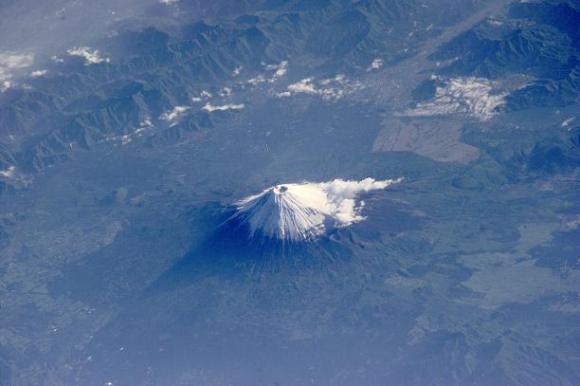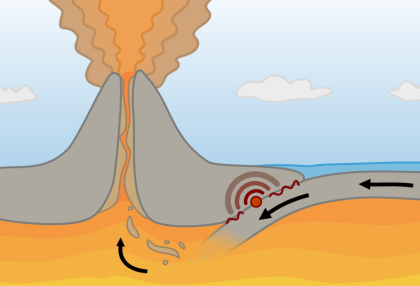According to retired professor Masaki Kimura of Ryukyu University, this and other recent phenomena indicate an eruption of Mt. Fuji should have taken place in 2011 with a four-year margin of error ending in 2015.
First, a little background on Mt. Fuji. Japan sits on the edge of a "subduction zone" which is where one layer of the Earth's crust is pushed under another. In the below image, courtesy of Google Maps, you can see the trench along which subduction is occurring around Japan.
This pushing is an ongoing process and results in part of the Earth's crust being pushed down into the hot magma of the Earth's mantle. However, because this crust is saturated with water, it mixes differently with the magma in the mantle causing a lighter material to rise back up through the top layer of crust.
This rising magma then becomes a magma chamber. Here, away from the mantle, various gases are released from the magma and accumulate. When pressure becomes stronger than the rock containing it, the rock pops open in a volcanic eruption.
Mt. Fuji was formed in this manner, and the subduction which occurs during large-scale earthquakes is believed to cause an increase in the magma chamber. The previous 1707 eruption of Mt. Fuji is said to have been triggered by a massive earthquake occurring near Osaka a month before.
Prof. Kimura believes that aside from the Tohoku earthquake there has been an overall increase in more "normal" seismic activity around the mountain - particularly on its northeast side.
"Magma is rising from beneath Mt. Fuji. Cracks in the crust have been growing. Some things hanging above have been falling. No one is pointing it out, but I think there is a possibility."By "things hanging", Prof. Kimura is possibly alluding to the partial collapse of the Sasago expressway tunnel in December last year, which killed nine. Authorities are still investigating the cause of the collapse and no earthquake was detected at the time, but deformation of the tunnel is speculated as being the cause.
Prof. Kimura also mentions the rise of the water level at Lake Sai which is located to the northeast of Mt. Fuji. At the time of the Tohoku earthquake, the lake's water-level rose by one meter. Kimura believes that this was caused by the permafrost near Fuji's summit melted by rising magma.
Prof. Kimura also claims that there have been a large number of phreatic eruptions - explosions of steam caused by heating of ground water from rising magma - around the mountain. No lava is released during these explosions, only water and rock.
However, some say that phreatic eruptions are precursors to major volcanic eruptions. Prior to the 1980 eruption of Mt. Saint Helens in the US, there were numerous reports of phreatic eruptions. This is a theory which Prof. Kimura seems to agree with.
"It looks like the danger of eruption is in the northeast corner of Mt. Fuji, but there is also a possibility of an eruption from the summit crater at the same time. Volcanic earthquakes are increasing, and their epicenters are becoming increasingly shallow."It should be noted that Prof. Kimura is co-author of Fujisan No Funka Wa Hajimatteiru! (The Eruption of Mt. Fuji Has Begun!), a book released in June last year, as well as author of 2011's Fujisan Dai Funka! Bukimina Itsutsu No Choko (Mt. Fuji's Big Eruption! Five Eerie Signs).
Also, despite the evidence at hand it is still difficult to predict disasters like earthquakes and volcanic eruptions with absolute accuracy.
However, in the event of a Mt. Fuji eruption, many speculate the cost to human life would be low due to the slow moving lava that would likely occur. On the other hand, the cost of damage to public and private property would undoubtedly be immense.
So if you're planning purchasing any property in the vicinity of Mt. Fuji, you might want to sit on it for a while.
Source:livedoor News via Hachima Kiko (Japanese)





can predict volcano eruptions ? Just asking...